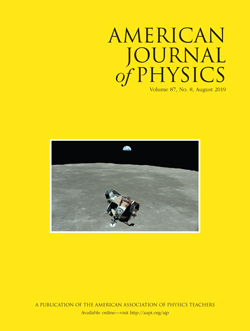 August 2019 Issue,
August 2019 Issue,
Volume 87, No. 8
The delicate dance of orbital rendezvous
The meeting of two spacecraft in orbit around a planet or moon involves a delicate dance that must carefully balance the gravitational, Coriolis, and centrifugal forces acting on the spacecraft. The intricacy of the relative motion between the two spacecraft caused problems for the Gemini missions in the mid-1960s. Although now mastered, the problem of how to bring two orbiting objects together continues to be misrepresented in popular movies and books. In this article, I will consider the case when the two spacecraft are in close proximity (compared with the radii of their orbits), and examine the counter-intuitive trajectories that are needed to bring them together. I will examine how a stranded astronaut might use an impulsive force to return to her ship in Earth orbit, how and when line-of-sight targeting may be used for a rendezvous, and how the Apollo 11 lunar module executed a Terminal Phase Initiation maneuver to rendezvous with the command/service module as they both circled the Moon.
Papers
Resource Letter: GP-1: Gender and Physics by Jennifer Blue, Adrienne Traxler, and Geraldine Cochran. DOI: 10.1119/1.5114628
The delicate dance of orbital rendezvous by Bradley W. Carroll. DOI: 10.1119/1.5115341
Maximal angular correlation in ? – ? coincidences: A quantitative study by Filipe Moura. DOI: 10.1119/1.5099891
Note on the history effect in fluid mechanics by Humphrey J. Maris. DOI: 10.1119/1.5100939
Free fall through the rotating and inhomogeneous Earth by Stefan Isermann. DOI: 10.1119/1.5100942
Data-driven decision making in an introductory physics lab by John R. Walkup, Roger A. Key, Patrick R. M. Talbot, and Michael A. Walkup. DOI: 10.1119/1.5100946
Why physical understanding should precede the mathematical formalism—Conditional quantum probabilities as a case-study byYakir Aharonov, Eliahu Cohen, and David H. Oaknin. DOI: 10.1119/1.5115980
Three-line derivation of the Thomas precession by Pawel Lewulis, and Andrzej Dragan. DOI: 10.1119/1.5115471
Back of the Envelope
Low-entropy expressions by Sanjoy Mahajan. DOI: 10.1119/1.5111838
Notes and Discussions
Alternative statements of the Rayleigh monotonicity law for linear time-invariant resistor networks driven by only voltages or only currents by Seppo J. Karrila, and Alex Karrila. DOI: 10.1119/1.5111962
Comment on “Peculiarities in the gravitational field of a filamentary ring” [Am. J. Phys. 87, 384–394 (2019)] by J. West. DOI: 10.1119/1.5115584
Entropy and unavailable energy by P.-M. Binder, Dallas K. Tada, and Cooper B. Howlett. DOI: 10.1119/1.5115145
Computational Physics
The hardwall method of solving the radial Schrödinger equation and unmasking hidden symmetries by Siu A. Chin, and John Massey. DOI: 10.1119/1.5111839
Book Reviews
BOOK REVIEWS by Robert Socolow American Journal of Physics 87, 606 (2019); https://doi.org/10.1119/1.5110249
The Simple Physics of Energy Use by Michael A. DuVernois. DOI: 10.1119/1.5098457
BOOKS RECEIVED
American Journal of Physics 87, 607 (2019); https://doi.org/10.1119/1.5110293
About AJP
General Information, Resources for Authors, Reviewers, and Readers

